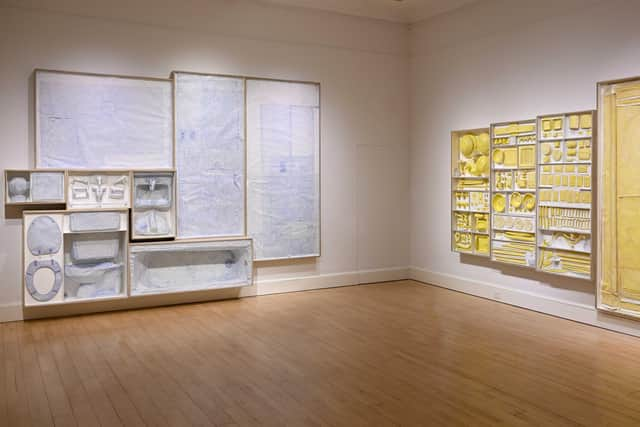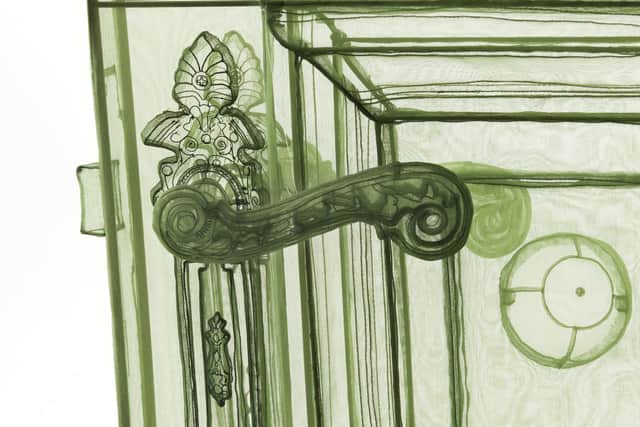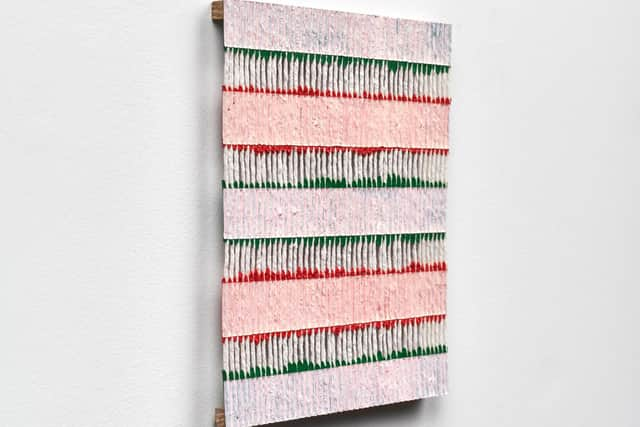Art reviews: Do Ho Suh | Brandon Logan
Do Ho Suh: Tracing Time, Scottish National Gallery of Modern Art, Edinburgh *****
Brandon Logan: Dog Rose, Ingleby Gallery, Edinburgh ****
What does home mean, in a world in which most of us will have many homes? What do we leave of ourselves in the places in which we’ve lived, and how do we carry those places with us?
Advertisement
Hide AdThe leading Korean artist Do Ho Suh, who left Seoul in his early twenties for the United States and has lived in London since 2010, is best known for making "architectural hubs”, sculptures which precisely recreate sections of his past homes in translucent fabric, and ambitious installations in which a small house is the central motif, balanced on the edge of the roof of the Jacobs School of Engineering at the University of California, San Diego, for example, or across a pedestrian walkway in London for Art Night.
This show, Suh’s first in Scotland and the first in Europe to focus on his works on paper, nods to these – there are three “hubs” and a film about the San Diego house, Fallen Star – but its focus is different, and arguably more interesting. Occupying the entire ground floor of Modern One and beautifully curated by NGS’s Stephanie Straine, it peels back the layers of Suh’s practice over the past 25 years, revealing something of where the ideas actually come from.
At the heart of the show is a room of drawings which are only rarely exhibited, and a collection of sketchbooks which never have been. Doubling as his journals, Suh considers these so private that even his studio team have never seen them. They contain the rawest ideas, the first manifestations of thought on paper.
In this room, we see many representations of home: a house running along on a pair of legs, or lifted, Wizard-of-Oz-style, by a tornado, dreamed up in a man’s head and – memorably – farted out of his body. The man in these pictures is often a self portrait: here is the self in relation to architectural space, his other selves, and other human beings past and present, the self juggling the fates of an unpredictable universe.


Some of these drawings are highly controlled, others loose and expressive. Almost everything else we see, from thread works and lithographs to animations and recent experiments with AI tools, can be related back to the ideas found here.
Suh had never used his drawings directly in his gallery work until he began making “thread drawings” at STPI Creative Workshop and Gallery in Singapore in 2009. Now a key part of his practice, they are made by stitching on to gelatine sheets, then the gelatine is dissolved in a water bath so the thread becomes embedded in handmade paper. They are a balance of precision, expressiveness and chance, and often reach an impressive scale. Colour is also key: in a large work like Staircase/s (2019), the stairs in the New York brownstone where Suh lived for a decade become a fantastical Jacob’s ladder ascending through a rainbow of colours.
Advertisement
Hide AdThe same house in West 22nd Street was also the subject of a very different project, Rubbing/Loving. After moving his belongings out, Suh attached paper to the walls and fixtures – the light switches, taps, cooker etc – and rubbed them with charcoal and chalks to create an impression similar to brass-rubbing. There is something heart-wrenching about the whole enterprise, its fragility and time-consuming care, as if he was trying to seal a memory in place which nevertheless remains elusive.
His work with clothes is similarly evocative. Returning to a 2006 installation, Uni-Form/s: Self-Portrait/s (My 39 Years), in which he brought together all the uniforms he had worn from kindergarten to military service, he casts some of the clothing in white paper. Displayed as three-dimensional sculptures lit from below, or pressed into reliefs, they are like shed skins, yellowing and intimate, holding the memory of a human body much more vividly than the clothes themselves.


Advertisement
Hide AdSomething else, though, about drawings: they are not constrained by reality or practicality. The imagination has free rein. Suh’s A Perfect Home – a watercolour sketch from 1999 – sits on a bridge which links Seoul, London and New York. From that idea, he developed a speculative project in which he invited scientists and engineers to help him imagine how it could be built. This sits among other “impossible” ideas, like a statue which can move and rebuild itself, devised at the time of Black Lives Matter, and Fallen Star, the odd one out because, however improbable it seemed, it was actually built.
This might be the central tension in Suh’s work, between the precision required to realise his ideas in three dimensions and the free-wheeling imagination which comes up with the ideas in the first place. The hubs are all precision, down to the last door handle and fire exit sign, but they are whimsical too, corridors and entrance halls, portals to memory or in which to imagine other lives.
Suh has said that seeing drawings in an exhibition is like a glimpse backstage at the theatre. This show pulls back the curtain on his own inner workings. One might make another Wizard of Oz analogy, but the effect is completely different: seeing the cogs and engines of the imagination at work doesn’t close things down, it opens up an entirely new perspective with which to view the rest of the work.
From an artist who draws with thread to one who makes paintings from string. Orkney-based Brandon Logan, who graduated from Edinburgh College of Art in 2019, is the youngest artist to have a solo show at the Ingleby Gallery. By laying down a fine grid of strings, and adding acrylic paint so it fuses and solidifies between them, he has, the gallery says, “come with with a genuinely new way of making abstract art”.


Like Suh, he experiments in the territory between precision and control: sometimes the paint creates clean lines and blocks, sometimes it is more freestyle. Each piece has a palette of carefully chosen colours, sometimes just two, rarely more than four. The use of pastel shades, in particular, is reminiscent of Bridget Riley.
That the colours are inspired by Orkney is the only clue he gives us. The work has the resolute abstract sensibility of refusing to be decoded or translated into meaning. The majority of the works are small (this is a year’s output, including many of the works which featured in his solo show at the Pier Arts Centre in Stromness last autumn), but a few are impressively big. Large-scale pieces such as The Creature, Ribcage and Devil’s Bit, are muscular and arresting, making use of strong shapes as well as colours.
Advertisement
Hide AdLogan has hit on a distinctive artistic language early and pursued it consistently – the roots of this work were present in his degree show. Only time will tell how he will come to balance precision and freedom, whether this very specific method will become a cage to be wrestled with, or a set of restraints which open up a place of endless possibilities.
Do Ho Suh: Tracing Time until 1 September; Brandon Logan: Dog Rose until 9 March